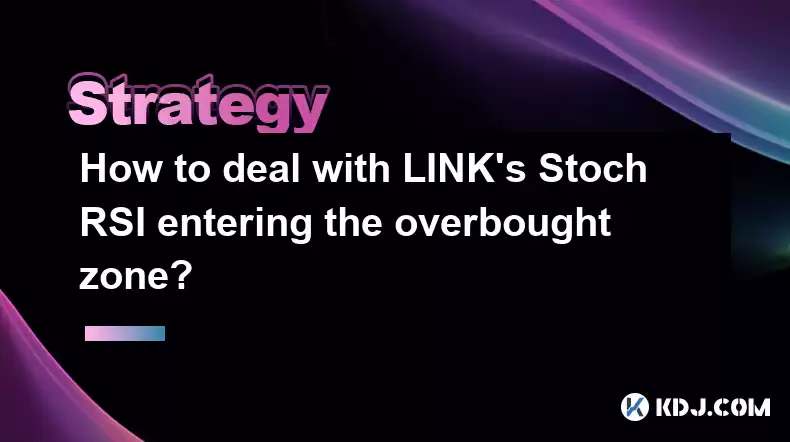-
 bitcoin
bitcoin $110918.433029 USD
-1.69% -
 ethereum
ethereum $3996.872473 USD
-2.43% -
 tether
tether $1.000594 USD
0.00% -
 bnb
bnb $1178.871834 USD
-2.38% -
 xrp
xrp $2.413973 USD
-3.47% -
 solana
solana $194.341461 USD
-4.24% -
 usd-coin
usd-coin $0.999963 USD
-0.03% -
 tron
tron $0.320092 USD
0.92% -
 dogecoin
dogecoin $0.196919 USD
-3.42% -
 cardano
cardano $0.669585 USD
-3.63% -
 hyperliquid
hyperliquid $37.485952 USD
-3.58% -
 ethena-usde
ethena-usde $1.000026 USD
-0.02% -
 chainlink
chainlink $18.018220 USD
-5.13% -
 bitcoin-cash
bitcoin-cash $523.879267 USD
-2.41% -
 stellar
stellar $0.324655 USD
-3.67%
How to deal with LINK's Stoch RSI entering the overbought zone?
When LINK's Stoch RSI enters the overbought zone, consider taking profits, setting stop-losses, or waiting for a pullback, and use other indicators to confirm signals.
Apr 27, 2025 at 07:56 am

When dealing with LINK's Stoch RSI entering the overbought zone, it's crucial to understand the implications and take appropriate actions to manage your investments effectively. The Stoch RSI is a momentum indicator that can help identify overbought and oversold conditions. When the Stoch RSI of LINK enters the overbought zone, it suggests that the asset might be due for a price correction or a potential downturn. This article will guide you through the steps and strategies to handle such a situation.
Understanding the Stoch RSI Indicator
The Stochastic RSI (Stoch RSI) is a technical indicator derived from the Relative Strength Index (RSI). It measures the level of the RSI relative to its high-low range over a set period, typically 14 days. The Stoch RSI oscillates between 0 and 1, with readings above 0.8 considered overbought and readings below 0.2 considered oversold. When LINK's Stoch RSI enters the overbought zone, it indicates that the asset's price may have risen too quickly and could be due for a pullback.
Analyzing the Overbought Signal
When you notice that LINK's Stoch RSI has entered the overbought zone, the first step is to analyze the signal in the context of other market indicators. Do not make hasty decisions based solely on the Stoch RSI. Consider the following factors:
- Price Action: Look at the recent price movements of LINK. If the price has been rising rapidly, the overbought signal might be more significant.
- Volume: High trading volume accompanying the price rise can confirm the overbought condition.
- Other Indicators: Check other technical indicators like the Moving Average Convergence Divergence (MACD) or Bollinger Bands to see if they also suggest a potential reversal.
Strategies for Dealing with Overbought Conditions
There are several strategies you can employ when LINK's Stoch RSI enters the overbought zone. Here are some approaches:
Taking Profits
If you are holding LINK and the Stoch RSI indicates an overbought condition, it might be a good time to take some profits. This strategy involves selling a portion of your holdings to lock in gains before a potential price drop.
- Determine the Amount to Sell: Decide how much of your LINK holdings you want to sell. A common approach is to sell 20-30% of your position.
- Set a Sell Order: Place a sell order at the current market price or slightly below to ensure execution.
- Monitor the Market: After selling, continue to monitor the market to see if the price continues to rise or starts to decline.
Setting Stop-Loss Orders
Another strategy is to set stop-loss orders to protect your investment from significant losses. A stop-loss order will automatically sell your LINK if the price falls to a certain level.
- Determine the Stop-Loss Level: Decide on a stop-loss level based on your risk tolerance. A common approach is to set the stop-loss at 5-10% below the current price.
- Place the Stop-Loss Order: Use your trading platform to place a stop-loss order at the chosen level.
- Adjust as Needed: You may need to adjust the stop-loss level as the price of LINK moves.
Waiting for a Pullback
If you believe in the long-term potential of LINK, you might choose to wait for a pullback before taking any action. This strategy involves holding onto your LINK and waiting for the price to correct before making a decision.
- Monitor the Stoch RSI: Keep an eye on the Stoch RSI to see if it moves out of the overbought zone.
- Watch for Support Levels: Identify key support levels where the price of LINK might find support during a pullback.
- Consider Buying More: If the price pulls back to a support level, you might consider buying more LINK at a lower price.
Using the Stoch RSI in Conjunction with Other Indicators
To increase the reliability of your trading decisions, it's essential to use the Stoch RSI in conjunction with other technical indicators. Here are some combinations to consider:
Stoch RSI and MACD
The Moving Average Convergence Divergence (MACD) is another momentum indicator that can help confirm the signals provided by the Stoch RSI.
- Look for Divergence: If the Stoch RSI is overbought and the MACD shows bearish divergence (the price is making higher highs while the MACD is making lower highs), it could be a strong signal to sell.
- Confirm the Signal: If both the Stoch RSI and MACD suggest a potential reversal, it increases the likelihood of a price correction.
Stoch RSI and Bollinger Bands
Bollinger Bands can help identify volatility and potential price reversals.
- Check the Bands: If the price of LINK is touching the upper Bollinger Band and the Stoch RSI is overbought, it could indicate that the price is overextended and due for a correction.
- Watch for a Breakout: If the price breaks below the middle Bollinger Band after being overbought, it could confirm a bearish move.
Practical Steps to Implement Your Strategy
Implementing your chosen strategy requires careful planning and execution. Here are the practical steps to follow:
- Review Your Portfolio: Before taking any action, review your overall portfolio to understand your exposure to LINK and other assets.
- Set Clear Goals: Define your investment goals and risk tolerance to guide your decision-making process.
- Execute Your Strategy: Follow the steps outlined in your chosen strategy, whether it's taking profits, setting stop-loss orders, or waiting for a pullback.
- Monitor and Adjust: Continuously monitor the market and adjust your strategy as needed based on new information and market conditions.
Frequently Asked Questions
Q: Can the Stoch RSI give false signals?A: Yes, the Stoch RSI can give false signals, especially in strong trending markets. It's important to use it in conjunction with other indicators and consider the broader market context to increase the reliability of the signals.
Q: How often should I check the Stoch RSI for LINK?A: The frequency of checking the Stoch RSI depends on your trading style. For short-term traders, checking it daily or even multiple times a day might be necessary. For long-term investors, weekly checks might be sufficient.
Q: Is it possible for LINK to remain overbought for an extended period?A: Yes, it is possible for LINK to remain overbought for an extended period, especially during strong bullish trends. In such cases, the overbought condition might not immediately lead to a price correction.
Q: Should I use the Stoch RSI as my only indicator for trading LINK?A: No, it's not advisable to use the Stoch RSI as your only indicator. Combining it with other technical indicators and considering fundamental analysis can provide a more comprehensive view of the market and improve your trading decisions.
Disclaimer:info@kdj.com
The information provided is not trading advice. kdj.com does not assume any responsibility for any investments made based on the information provided in this article. Cryptocurrencies are highly volatile and it is highly recommended that you invest with caution after thorough research!
If you believe that the content used on this website infringes your copyright, please contact us immediately (info@kdj.com) and we will delete it promptly.
- Nevada Coin Mart: Where the Sparkle Meets Serious Coin Collecting
- 2025-10-17 02:45:17
- $IPO Token Presale: Aiming for $100M AUM and Revolutionizing Early Investment
- 2025-10-17 02:45:17
- Binance Under Fire: Outflows, FUD Campaigns, and the Fight for User Confidence
- 2025-10-17 02:50:01
- Lombard, Bitcoin, and IP Rails: Revolutionizing the Creator Economy
- 2025-10-17 02:50:01
- Quantum-Safe Bitcoin: BTQ Technologies' Leap in Cryptocurrency Network Security
- 2025-10-17 02:50:01
- Lincoln Cent Rolling Mill Errors: A Deep Dive into Lumpy Ridges
- 2025-10-17 02:25:12
Related knowledge

Practical parameter settings for a Bitcoin multi-timeframe moving average system
Sep 18,2025 at 10:54pm
Optimizing Timeframe Combinations for Bitcoin Trading1. Selecting appropriate timeframes is crucial when building a multi-timeframe moving average sys...

How can I filter out false breakouts in Dogecoin high-frequency trading?
Sep 22,2025 at 01:00am
Understanding False Breakouts in Dogecoin Trading1. A false breakout occurs when Dogecoin's price appears to move beyond a defined support or resistan...

Techniques for identifying tops and bottoms in the Bitcoin on-chain NVT model
Sep 20,2025 at 07:54pm
Understanding the NVT Model in Bitcoin Analysis1. The Network Value to Transactions (NVT) ratio is often described as the 'P/E ratio' of the cryptocur...

What does the surge in open interest in Bitcoincoin futures mean?
Sep 20,2025 at 11:18pm
Understanding the Surge in Dogecoin Futures Open Interest1. A surge in open interest within Dogecoin futures indicates a growing number of active cont...

How can I use the Ethereum USDT premium to gauge market sentiment?
Sep 18,2025 at 11:55pm
Understanding the Ethereum USDT Premium1. The Ethereum USDT premium refers to the price difference between USDT (Tether) traded on Ethereum-based plat...

What should I do if Ethereum staking yields decline?
Sep 20,2025 at 06:18am
Understanding the Causes Behind Declining Ethereum Staking Yields1. The Ethereum network transitioned to a proof-of-stake consensus mechanism with the...

Practical parameter settings for a Bitcoin multi-timeframe moving average system
Sep 18,2025 at 10:54pm
Optimizing Timeframe Combinations for Bitcoin Trading1. Selecting appropriate timeframes is crucial when building a multi-timeframe moving average sys...

How can I filter out false breakouts in Dogecoin high-frequency trading?
Sep 22,2025 at 01:00am
Understanding False Breakouts in Dogecoin Trading1. A false breakout occurs when Dogecoin's price appears to move beyond a defined support or resistan...

Techniques for identifying tops and bottoms in the Bitcoin on-chain NVT model
Sep 20,2025 at 07:54pm
Understanding the NVT Model in Bitcoin Analysis1. The Network Value to Transactions (NVT) ratio is often described as the 'P/E ratio' of the cryptocur...

What does the surge in open interest in Bitcoincoin futures mean?
Sep 20,2025 at 11:18pm
Understanding the Surge in Dogecoin Futures Open Interest1. A surge in open interest within Dogecoin futures indicates a growing number of active cont...

How can I use the Ethereum USDT premium to gauge market sentiment?
Sep 18,2025 at 11:55pm
Understanding the Ethereum USDT Premium1. The Ethereum USDT premium refers to the price difference between USDT (Tether) traded on Ethereum-based plat...

What should I do if Ethereum staking yields decline?
Sep 20,2025 at 06:18am
Understanding the Causes Behind Declining Ethereum Staking Yields1. The Ethereum network transitioned to a proof-of-stake consensus mechanism with the...
See all articles










































































